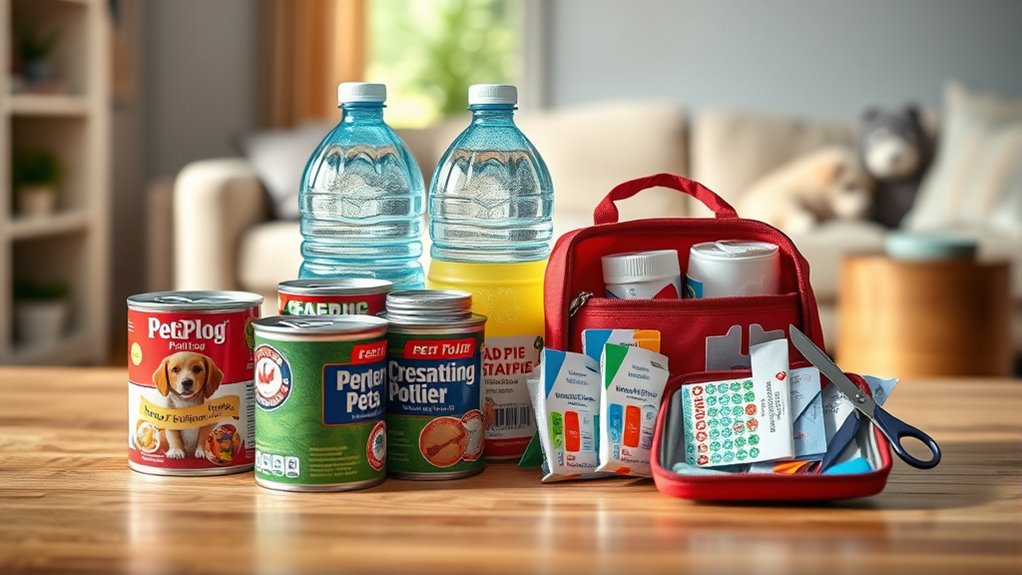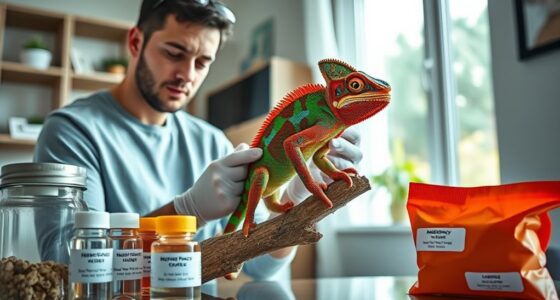To build a pet emergency kit, start by gathering enough food and water to last at least three days, stored in airtight containers and portable bowls. Include a well-stocked first aid kit with basic supplies, medications, and copies of medical records. Don’t forget essentials like a leash, ID tags, flashlight, and blankets to keep your pet safe and comfortable. Organizing these items guarantees you’re prepared for any situation—continue exploring for detailed tips and checklists.
Key Takeaways
- Include at least 3 days’ supply of pet food in airtight containers, checking expiration regularly.
- Pack bottled water and portable bowls to ensure hydration during emergencies.
- Stock a pet first aid kit with gauze, antiseptics, medications, and digital thermometer for quick injury management.
- Add essential items like a leash, collar, flashlight, blankets, and waterproof container for safety and organization.
- Regularly review and update the kit to keep supplies in good condition and ready for emergencies.

Have you ever wondered what you’d do if your pet suddenly faced an emergency? It’s a situation no pet owner wants to imagine, but being prepared can make all the difference. Building a pet emergency kit is a crucial step in ensuring pet safety and being ready for unexpected events. When you assemble this kit, you’re taking proactive measures that can help keep your furry friend safe, calm, and healthy during stressful times. Emergency preparedness isn’t just about having a plan; it’s about having the right supplies readily available so that, when disaster strikes, you can respond quickly and effectively.
Start by including essential food and water supplies. Keep enough pet food to sustain your pet for at least three days, considering their dietary needs and any special restrictions. Store the food in airtight containers to prevent spoilage, and regularly check expiration dates to ensure freshness. Water is just as important—have bottled water or a reliable water supply that can provide hydration for several days. Remember, in emergencies like natural disasters, clean water can become scarce, so having an ample supply is essential. Consider portable water bowls that are lightweight and easy to carry, especially if you need to evacuate quickly. Incorporating emergency preparedness principles can greatly enhance your ability to respond effectively in crisis situations. Additionally, understanding emergency response techniques can equip you with the skills needed to handle unexpected situations calmly and efficiently. Having access to credit card insights can also be useful if you need to make urgent purchases or payments during such situations.
Furthermore, using a portable, high-quality home theatre projector can be a comforting distraction for pets during stressful situations, helping to reduce their anxiety. This is especially helpful if your pet is sensitive to loud noises or unfamiliar environments. Next, focus on first aid supplies. A well-stocked pet first aid kit is imperative for addressing minor injuries or stabilizing your pet until professional help arrives. Include items like gauze, antiseptic wipes, tape, scissors, tweezers, and a digital thermometer. It’s also wise to have specific medications your pet may need, along with copies of their medical records in case you need to visit an unfamiliar veterinarian. Training yourself on basic pet first aid techniques can make a significant difference if your pet gets injured. In stressful situations, your calm and confident handling can help reduce their anxiety and prevent further harm.
Beyond food, water, and first aid, consider adding items like a leash, a collar with ID tags, a flashlight, batteries, and a blanket. These supplies help keep your pet secure and comfortable while you navigate an emergency. Store everything in a durable, waterproof container that’s easy to grab and transport, so you’re ready to evacuate at a moment’s notice. Staying organized and periodically reviewing your kit guarantees you won’t be caught off guard. Building a comprehensive pet emergency kit isn’t just about having supplies; it’s about creating peace of mind, knowing you’re prepared to protect your pet’s safety no matter what happens.
In addition, understanding animal health and recognizing signs of distress can help you respond more effectively during an emergency.
Frequently Asked Questions
How Often Should I Update My Pet Emergency Kit?
You should update your pet emergency kit regularly to guarantee it’s ready when needed. For kit maintenance, check your supplies every 3 to 6 months, and do inventory updates to replace expired or used items. Also, update your pet’s medications and food based on their current needs. Keeping your kit current helps you respond quickly during emergencies, so make this a routine part of your preparedness.
What Are Signs My Pet Is Stressed During an Emergency?
When your pet starts acting like it’s auditioning for a drama, you know stress is in play. Signs of pet anxiety during an emergency include trembling, excessive panting, hiding, or relentless pacing—classic emergency behavior. Keep a keen eye for these cues, because recognizing stress early helps calm your furry friend. Remember, in chaos, your pet’s signals are their way of telling you they need reassurance, not a starring role.
Should I Include Medications or Supplements in the Kit?
You should definitely consider medications inclusion and supplement considerations for your pet’s emergency kit. If your pet takes any prescribed medications, include enough for several days, along with instructions. Supplements that support your pet’s health or calmness can also be helpful. Always consult your veterinarian before adding any medications or supplements to guarantee safety and appropriateness during emergencies. This preparation helps keep your pet safe and comfortable when it counts most.
How Can I Make My Pet’s Kit Accessible During a Disaster?
Think of your pet’s emergency kit as a treasure chest that needs to be ready at a moment’s notice. To make certain it’s quickly accessible, choose a storage location that’s easily reachable, even in chaos—like near your door or in a designated emergency cabinet. Consider accessibility factors such as size, visibility, and ease of opening. Regularly check and update the kit so it’s always prepared, just like a hero’s toolkit, waiting for action.
Are There Specific Items for Elderly or Special Needs Pets?
When preparing for emergencies, you should include senior pet supplies and make special needs modifications to your kit. Consider adding items like mobility aids, medications, and extra soft bedding for elderly or special needs pets. Make certain these items are easily accessible and clearly labeled. By customizing your kit, you help your pet stay comfortable and safe during a disaster, addressing their unique needs effectively.
Conclusion
Now that you’ve gathered all the essentials, your pet is better prepared for any emergency. Keep the kit in a handy spot—think modern-day knight’s armor, but for your furry friend. Remember, disasters can strike like a bolt of lightning from a clear sky, so stay vigilant and update your supplies regularly. With a little prep, you’ll be ready to shield your pet from harm and keep them safe through thick and thin.










